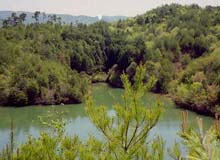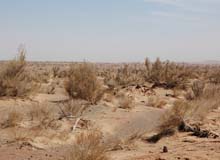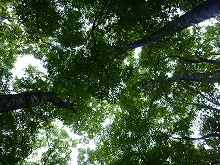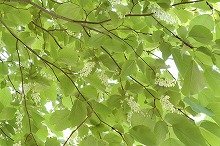Forest Ecology
Forest Ecology
Ecophysiological analysis of environmental stress on tree species Nutrient dynamics in forest ecosystems Ecological studies on forest dynamics and the reproductive system of forest trees
Forest Ecology unit URLStaff
 | Assoc. Prof. Dr. HIROBE Muneto E-mail: mhirobe@ (@okayama-u.ac.jp) Research area: forest ecology, material cycling in forest ecosystems |
 | Dr. MIYAZAKI Yuko E-mail:yukomiyazaki@(@okayama-u.ac.jp) Research area: forest ecology, plant physiology, reproduction of trees |
Research Subjects
Because of human activity, vegetation is being destroyed and desertification is proceeding rapidly in many terrestrial ecosystems. In addition, global environmental change inevitably affects even undamaged ecosystems. We study the ecophysiology of trees under various environmental stresses to develop sustainable revegetation and vegetation conservation techniques. We also study the biogeochemical cycles of nutrients to clarify the structure and functions of terrestrial ecosystems.
Stress tolerance of trees
|
Trees develop a variety of physiological and ecological characteristics against stress caused by drought or excessive moisture. In order to clarify these properties in connection with soil, plants, and the atmosphere, we conduct field research and laboratory experiments. In particular, we try to describe the phenological response to drought stress of drought-resistant plants, such as the relationship between drought resistance and mechanisms to maintain water flow, and growth responses toward drought stress. We also conduct composition analysis and measurement of the fluorescence reaction of photosynthetic pigments which are associated with light stress tolerance, because plants growing in arid regions receive strong light stress. It is necessary to demonstrate the mechanisms of stress tolerance including drought stress in order to develop techniques for sustainable management of arid ecosystems. |  |
Forest management in semi-arid regions
|
In order to prevent the spread of arid regions in northeast Asia where yellow sand arises from desertification, it is necessary to develop techniques for the sustainable utilization of forest and grassland, and for recovery and maintenance of degraded vegetation. As basic research for solving these issues, we conduct several studies on the physiological and ecological features of plants growing in arid regions in China and Mongolia. |  |
Spatial heterogeneity of nutrient cycles within a forest ecosystem
|
We try to clarify the nutrient cycles within forest ecosystems. Nutrient cycles are the most fundamental processes among organisms and physical environments, and directly relate to the structure and functions of ecosystems. Nutrient cycles show considerable variations at various spatial and temporal scales, and we are especially interested in the spatial heterogeneity of nutrient cycles (patterns and their controlling factors) at smaller spatial scales less than the landscape scale. Our research has been performed in plantation and natural forests in Japan, in tropical forests in Malaysia and Thailand, in boreal forests in Siberia and Alaska, and also in other terrestrial ecosystems (semi-arid shrub zones and grasslands in China and Mongolia). |  |
Reproductive response of tree species under global environmental change
|
Many plants have intermittent and synchronized production of large numbers of flowers or seeds by a population (called masting). Several hypotheses have been proposed to explain the mechanism of masting; it is most likely that plants respond to both internal resource levels and external environmental cues to initiate flower and produce seeds. However, how and in what processes these factors influence the floral initiation and seed production is unknown. Currently, we are trying to answer these questions using genomic tools to document which candidate genes show endogenous or exogenous associations in Fagus and Quercus species. This work demonstrates the impact of the seed production cycle and magnitude on forest dynamics in the face of environmental change. |  |
Publications
- Yoshikawa, K., Ohte, N. and Wang, R. : Effect of drought on the groundwater level in the Mu-Us desert, Inner-Mongolia, China. J. Arid Land Studies 14, 131-133, 2004
- Akaji, Y., Hirobe, M., Harada, M., Otoda, T., Yamanaka, N., and Sakamoto, K. : Microphysical environmental factors affecting the local distribution of dwarf bamboo (Sasa palmata) in a cool-temperate deciduous broadleaf forest in Japan. Ecoscience, DOI: 10.2980/20-3-3640, in press.
- Hirobe, M., Kondo, J., Enkhbaatar, A., Amartuvshin, N., Fujita, N., Sakamoto, K., Yoshikawa, K. and Kielland, K. : Effects of livestock grazing on the spatial heterogeneity of net soil nitrogen mineralization in three types of Mongolian grasslands. J. Soil. Sediment, 13, 1123-1132, 2013.
- Miyazaki Y. 2013. Dynamics of internal carbon resources during masting behavior in trees. Ecological Research 28: 143?150.
- Miyazaki Y, Osawa T, Waguchi Y. 2009. Resource level as a proximate factor influencing fluctuations in male flower production in Cryptomeria japonica D. Don. Journal of Forest Research 14: 358-364.